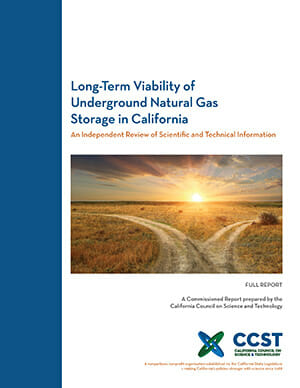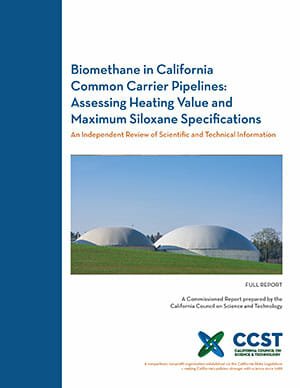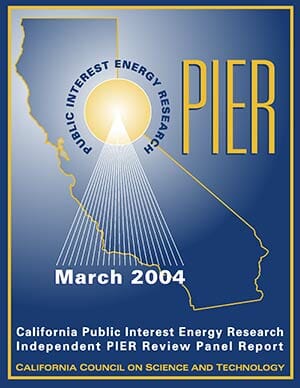Long-Term Viability of Underground Natural Gas Storage in California: An Independent Review of Scientific and Technical Information
Author(s): Long, Jane C.S.; Birkholzer, Jens T.; Mace, Amber J.; Brady, Sarah E.
Release Date: January 18, 2018 | Last Updated Date: February 5, 2018
Abstract
In response to Governor Brown’s January 2016 state of emergency proclamation regarding the Aliso Canyon gas leak, SB 826 (Leno, 2016) requested that the California Council on Science and Technology (CCST) provide the State with up-to-date information on all currently operating underground natural gas storage fields in California. CCST was instructed to provide an independent technical assessment answering three key questions about:
- The risks California’s underground gas storage facilities pose to health, safety, environment, and infrastructure;
- Whether California needs underground gas storage to provide for energy reliability through 2020; and
- How implementation of California’s climate policies changes the future need for underground gas storage.
From a statewide field of leading energy researchers, CCST selected Jens T. Birkholzer, PhD, and Jane C.S. Long, PhD, to serve as co-chairs of the 12-member CCST Report Steering Committee – which supervised 21 Report Authors with expertise spanning hydrogeology and reservoir engineering, risk assessment, public and occupational health, greenhouse gas (GHG) emissions, and energy analysis and economics. Each report chapter was subject to a peer review process by independent experts, while another independent expert served as Report Monitor to oversee the process, ensuring that peer review comments were sufficiently addressed in the final report. An additional Oversight Committee reviewed the entire process, including conflict-of-interest declarations.
The report’s findings and conclusions are based on a review of published literature and official and voluntary databases, which the Report Authors compiled between January through September 2017, and delivered to the California Public Utilities Commission in January 2018. Key findings and conclusions include:
- Safety: The risks associated with underground storage (UGS) facilities can be managed, and, with appropriate regulation and safety management, may become comparable to risks in other types of energy facilities found acceptable in California, such as oil refineries and natural gas power plants. At each UGS facility, the State should ensure timely and thorough implementation of the new regulations coming into force in 2018 set by the California Department of Conservation’s Division of Oil, Gas, and Geothermal Resources (DOGGR). Those regulations emphasize new and safer well completions, risk and safety management plans, and requirements for well integrity testing and monitoring. The report recommends that the State go further and require more quantitative risk assessment activities, including consideration of human and organizational factors affecting risk. The State should also implement an independent and mandatory review program to evaluate the effectiveness of these new regulations and the rigor of their application in practice, with opportunity for public comment and public dissemination of the review results.
- Facility-by-Facility Evaluation: Any industrial operation involves some risk to health, safety, and environment. This report assessed various risk-related characteristics across UGS facilities in California, and found a small list of facilities had relatively higher potential risk compared to others.
- Reliability of Natural Gas Supply: California’s energy system currently requires natural gas and UGS facilities to run reliably, primarily because many residential and commercial buildings in California rely on natural gas for heating during the winter, and because natural gas provides electricity when solar and wind power are not available. The peak demand for natural gas during the winter currently exceeds the ability of pipelines to bring natural gas into the State of California, so natural gas must be stored during periods of low demand in order to have it available to meet peak demand.
- Near-Term Alternatives to UGS: Closing any or all UGS facilities in the near term would involve replacing UGS facilities with new pipelines or natural gas storage capacity, and require very large investments. Such new natural-gas-related infrastructure would bring its own risks and would further obligate the State to the use of natural gas for decades. The risks, costs, and benefits associated with alternatives to UGS storage should be evaluated accordingly.
- Long-Term Need for Underground Gas Storage: California’s climate policies in future decades could still necessitate the continued use of natural gas. Also, energy systems that meet the climate goals may require underground storage of natural gas, biogas, or hydrogen, as well as sequestration of carbon dioxide. The State should develop a more complete and integrated plan to understand how the role of natural gas might evolve; assess possible energy portfolios that both meet GHG emission constraints and achieve energy reliability; and consider the potential need for UGS facilities in the future.






